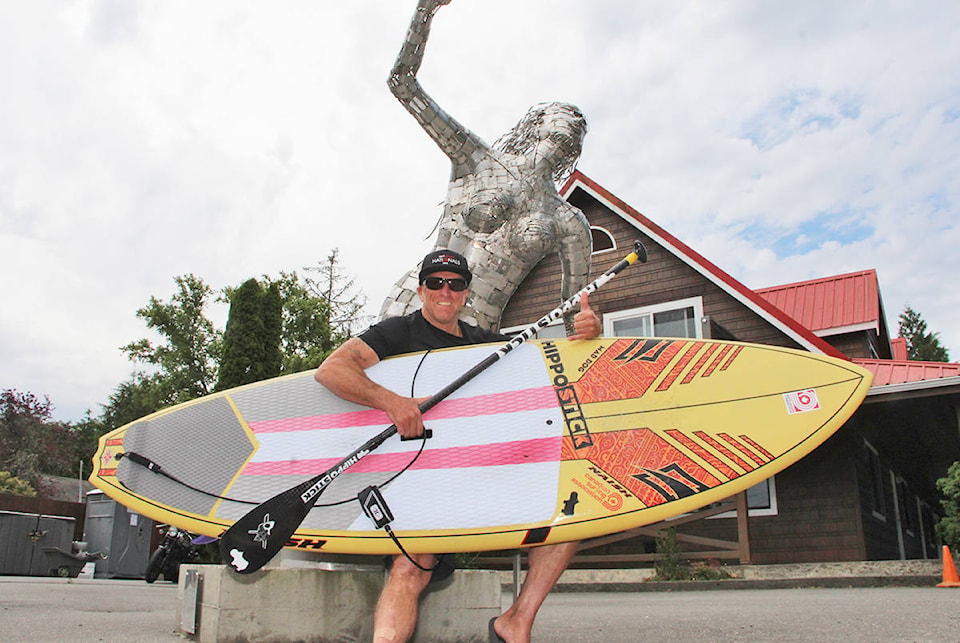An already audible, local call to return lifeguards to Long Beach got louder last week when a Ucluetian paddle boarder helped pull two stranded tourists off Lovekin Rock.
Mario Chartrand told the Westerly News he was enjoying a paddle in the area on June 30 when he caught an ominous scene out of the corner of his eye.
“I looked out to [Lovekin] Rock and I saw a board up on the ledge and I thought, ‘Hmm that doesn’t look good,’” he said.
He alerted his paddling partner Liz Thechen, a first responder from Richmond, and the pair made their way over to Lovekin.
“I know that you just can’t wait for things to evolve in terms of rescue. If you can do something to get somebody out of harm’s way, that’s the way to go. I’d feel really bad if I heard later on that day that there was a death and I could have done something,” he said.
“It took us about 10 minutes to get there and, as I got really close to the rock, I was in dismay. I really couldn’t believe what I saw.”
He said two men were laid out on a ledge on the rock, too scared to get off.
“They were right in that zone where the rip goes in two directions and it splits off the rock…I don’t think they even had a clue what they were getting into,” he said. “I think they managed to scramble up the mussels and claw themselves up onto the rock, or they had maybe a wave surge that brought them up, and they were able to just flop themselves onto that ledge. And then, once they were on that ledge, they weren’t moving.”
He said he and Thechen approached the men, and took roughly 15 minutes to tow them to safety.
“I don’t think they were going to be on that ledge for much longer because the tide was coming up quite fast,” he said. “[One of the men] said that he was tired and scared and cold and I said, ‘No, no, no; you have you get in the water’…He just didn’t have the body language to be comfortable in the water, so I just told him to drape his arms over the board. It was quite the arduous tow because, every time I took a stroke, it was like a really hard tug. I wasn’t sure if I was moving forward, but I was. I was getting the odd bump here and there.”
Two visitors have died near Lovekin Rock in 2018, prompting locals to lobby for the return of the Surf Guard program, which involved lifeguards looking over ocean activity from a tower near Lovekin Rock, but the Pacific Rim National Park Reserve is sticking with its current educational approach to safety.
“The Surf Guard program, which ran during summer months in one section of Long Beach, concluded in 2012 as it was no longer in step with evolving surf and water recreation practices in the area,” said Parks Canada spokesperson Laura Judson.
She said surfing is no longer centralized at Long Beach as the sport has stretched throughout the peninsula between Tofino and Ucluelet.
“Since it is not feasible to provide Surf Guard services over such a dispersed area and time period, Parks Canada has partnered with Ucluelet and Tofino to raise awareness of water hazards through the CoastSmart program,” she said. “Through CoastSmart, we educate people on the dangers of tides, unexpected waves, the power of rip currents, and the debilitating effects of cold water.”
She said about 1 million visitors come to the National Park Reserve each year and the CoastSmart program offers a multifaceted approach to communicate safety information to each visitor through signage at the beach, a website, a water safety app and social media.
“Safety is everyone’s responsibility. We urge visitors to make use of these tools and, in keeping with CoastSmart, know before they go near the water,” she said. “Parks Canada staff also share safety information directly with visitors on and off the beaches. In addition to this, we collaborate with local business and surf schools to help visitors know before they go near the water.”
She added there is a sign in place warning beachgoers of the dangers around Lovekin Rock and said new safety signage was recently installed in the area.
Chartrand, though, does not believe signage is enough and that a heavier staff presence is needed to warn visitors of ocean dangers face-to-face.
“There is a sign there that explains [Lovekin Rock’s] rip factors and what potentials are there but, if they miss that sign, then they don’t know,” Chartrand said. “You can put up all the signs in the world, but people don’t read signs…This is not going to be the last time that somebody goes pitching onto that rock. It’s going to keep happening.”
Judson said Pacific Rim National Park Reserve staff were unaware of the June 30 rescue and that Parks Canada is collaborating with local surf instructors to learn more about unreported incidents in an effort to shape outreach efforts on ocean safety. Anyone who spots an incident, is encouraged to report it to 1-877-852-3100.
